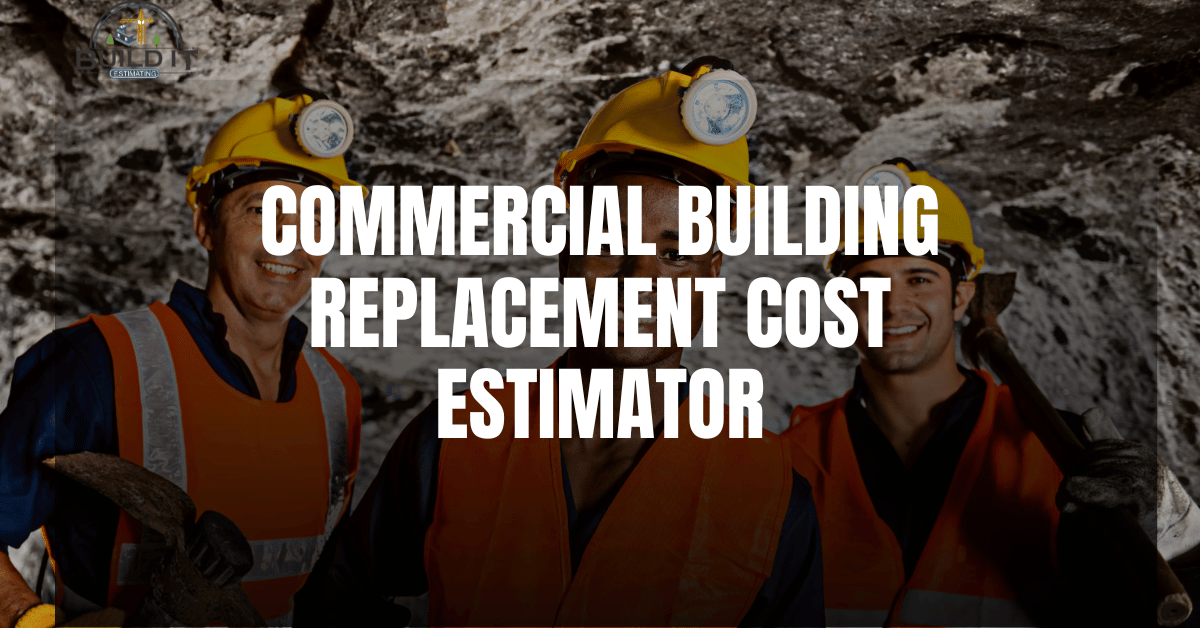Commercial building replacement projects are complex undertakings that require meticulous planning and precise cost estimation. A commercial building replacement cost estimator is an invaluable asset in this process, providing detailed and accurate cost projections that help stakeholders manage budgets, avoid cost overruns, and ensure project success.
A commercial building replacement cost estimator is a professional who specializes in predicting the costs associated with replacing commercial buildings. This role is crucial in construction projects, as it provides a financial roadmap that guides decision-making and resource allocation.
The Role of a Commercial Building Replacement Cost Estimator
The primary responsibilities of a commercial building replacement cost estimator include analyzing project specifications, evaluating material and labor costs, and providing a comprehensive cost breakdown. By identifying potential cost-saving opportunities and mitigating financial risks, they contribute to the overall efficiency and profitability of a project.
Benefits of Using a Commercial Building Replacement Cost Estimator
Utilizing a commercial building replacement cost estimator offers several benefits, the most notable being cost savings. Accurate cost estimates prevent budget overruns by identifying potential expenses early in the planning process. This allows for better financial planning and allocation of resources, ultimately saving money. Additionally, estimators enhance time efficiency by streamlining the estimation process, enabling quicker decision-making. Risk reduction is another key benefit, as precise estimates help to identify and mitigate potential financial risks associated with the project.
Components of a Building Replacement Cost Estimate
A thorough building replacement cost estimate includes several components, such as material costs, labor costs, equipment costs, and contingency allowances. Material costs cover the expenses for all building materials, including structural elements, finishes, and fixtures. Labor costs account for the wages of construction workers, supervisors, and other personnel involved in the project. Equipment costs involve the rental or purchase of machinery and tools required for construction. Contingency allowances are set aside to cover unforeseen expenses, ensuring the project remains financially stable despite unexpected challenges.
Factors Influencing Building Replacement Costs
Various factors can influence the cost of replacing a commercial building. The size and complexity of the building significantly affect the overall cost, with larger and more intricate structures requiring more materials and labor. The location of the building also plays a role, as it impacts transportation costs, local labor rates, and regulatory requirements. Material selection is another crucial factor, as the choice of materials can vary widely in cost and availability. Market conditions, including fluctuations in material prices and labor availability, can also impact the overall cost estimation.
Methods of Cost Estimation in Building Replacement
Several methods are employed in cost estimation for building replacement projects. Detailed estimating involves a comprehensive analysis of all project components, providing highly accurate cost projections. Parametric estimating uses statistical models based on historical data and project parameters to predict costs. Comparative estimating involves comparing the current project with similar past projects to estimate costs. Bottom-up estimating starts with detailed estimates for individual components and aggregates them to form a total project estimate.
Technological Advancements
The advent of technology has significantly enhanced cost estimation processes. Estimation software, such as ProEst, RSMeans, and PlanSwift, offer automated calculations, real-time updates, and integration with project management tools. Building Information Modeling (BIM) integration allows for detailed 3D modeling and simulation of construction projects, improving accuracy and collaboration. Real-time cost tracking tools enable continuous monitoring of project expenses, ensuring adherence to the budget and timely identification of cost deviations.
Challenges in Building Replacement Cost Estimation
Despite the advancements in technology, building replacement cost estimation is not without its challenges. Common pitfalls include incomplete project specifications, fluctuating material prices, and unforeseen project complications. Strategies to mitigate these challenges include maintaining clear communication with stakeholders, staying informed about market trends, and using contingency planning. Real-life examples of successful projects demonstrate the importance of thorough planning and accurate estimation in overcoming these challenges.
Best Practices for Accurate Cost Estimation
To ensure accurate cost estimation, several best practices should be followed. These include maintaining a systematic approach to estimation, using reliable data sources, and adhering to industry standards. Precision can be enhanced by double-checking calculations, using up-to-date cost databases, and considering all project variables. An efficient workflow involves breaking down the estimation process into manageable steps and using project management tools to track progress and ensure consistency.
Case Studies: Cost Savings through Accurate Estimation
Examining real-world examples of successful building replacement projects can provide valuable insights into the benefits of accurate cost estimation. These case studies highlight how precise estimation contributed to cost savings, efficient resource allocation, and timely project completion. Key learnings from these projects include the importance of early and detailed estimation, effective communication among stakeholders, and the use of advanced estimation tools.
The Process of Commercial Building Replacement Cost Estimation
The process of commercial building replacement cost estimation typically involves several stages. The initial assessment includes a thorough review of project specifications and requirements. Detailed analysis involves the breakdown of costs for materials, labor, equipment, and contingencies. The final estimation is a comprehensive cost projection that guides project budgeting and financial planning. This structured approach ensures all aspects of the project are considered and accounted for, providing a solid financial foundation for the project.
Training and Certification for Cost Estimators
Cost estimators require a combination of technical knowledge and practical skills to excel in their roles. Essential skills include proficiency in estimation software, understanding of construction processes, and strong analytical abilities. Certification programs, such as those offered by the American Society of Professional Estimators (ASPE) and the Association for the Advancement of Cost Engineering (AACE), provide formal recognition of an estimator’s expertise. Continuous professional development through workshops, courses, and industry conferences helps estimators stay updated on best practices and emerging trends.
Choosing the Right Cost Estimation Service Provider
Selecting the right cost estimation service provider is crucial for project success. Key criteria for selection include the provider’s experience, expertise, and track record of successful projects. It is essential to ask questions about their estimation process, the software they use, and how they handle challenges. Warning signs to watch out for include a lack of transparency, inconsistent communication, and a history of inaccurate estimates. Choosing a reliable and experienced provider ensures accurate cost projections and a smooth project execution.
Frequently Asked Questions about Building Replacement Cost Estimation
What is a commercial building replacement cost estimator? A commercial building replacement cost estimator is a professional who specializes in predicting the costs associated with replacing commercial buildings.
How does accurate cost estimation save money? Accurate cost estimation prevents budget overruns, allows for better financial planning, and helps identify potential cost-saving opportunities.
What factors influence building replacement costs? Factors include building size and complexity, location, material selection, and market conditions.
How has technology impacted cost estimation? Technology has enhanced cost estimation through the use of advanced software, BIM integration, and real-time cost tracking tools.
What should I consider when choosing a cost estimation service provider? Consider the provider’s experience, expertise, track record, estimation process, and the software they use. Look for transparency and effective communication.
Conclusion
In conclusion, a commercial building replacement cost estimator is essential for the successful planning and execution of building replacement projects. Accurate cost estimates provide a solid foundation for project budgeting, resource allocation, and risk management. By leveraging modern technology, following best practices, and selecting the right service provider, project managers can ensure their projects are completed efficiently and cost-effectively. Investing in professional cost estimation services is a wise decision that can save time, money, and resources, ultimately contributing to the success of any commercial building replacement project.

